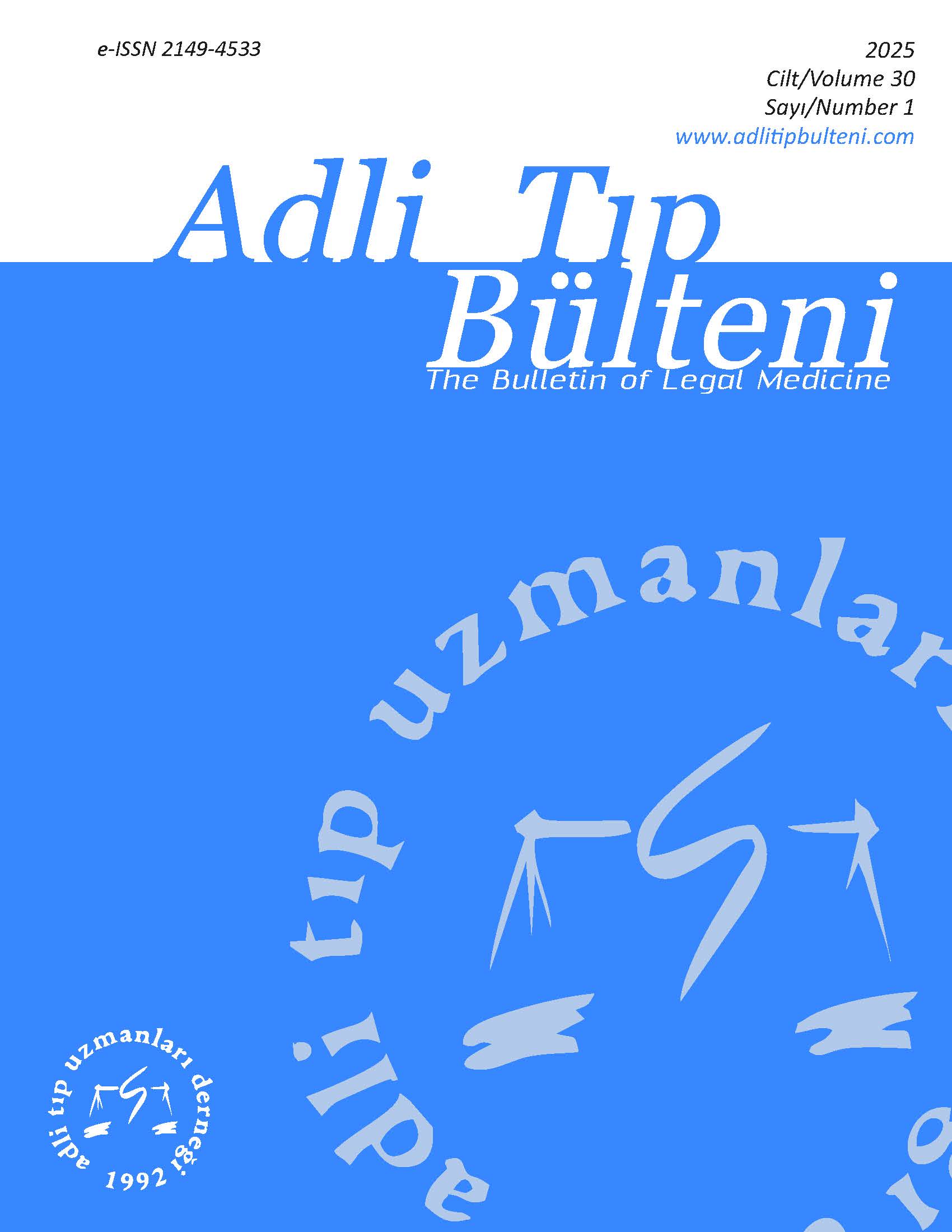Adli Fizik Eğitiminde Sanal Gerçeklik Teknolojisinin Kullanımı
DOI:
https://doi.org/10.17986/blm.1730Anahtar Kelimeler:
Adli Balistik- Adli Bilimler- Balistik Sarkaç- Sanal GerçeklikÖz
Amaç: Üç boyutlu görselleştirme teknolojisi kullanılarak temel balistik eğitimi için balistik sarkaç deneyine yönelik bir sanal gerçeklik aracının geliştirilmesi amaçlanmıştır.
Yöntem: Sanal ortamda deney geliştirme süreci; (i) bilimsel hazırlık süreci, (ii) grafik tasarım ve 3D modelleme süreci ve (iii) yazılım süreci olmak üzere üç aşamada gerçekleştirildi. Mermi çekirdeğinin namludan çıkış hızını hesaplamayı amaçlayan “Balistik Sarkaç Deneyi”, 7 farklı mühimmat seçeneği ile kullanıcıların deney başlangıç parametrelerini değiştirerek ölçüm ve hesaplama yapmalarına imkân verecek şekilde geliştirildi.
Bulgular: Deney yazılımı 9x19 Parabellum mühimmat seçilerek çalıştırıldı ve test entegrasyonları gerçekleştirildi. Deneyde 5.7 gram kütleli mermi çekirdeği dönme noktasına 1.3 metre mesafede 4 kg kütleli sarkaç takozuna merkezi tam esnek çarpışma yaparak saplandı. Açısal momentumun ihmâl edilerek sadece lineer momentum hesaba katıldığında mermi çekirdeğinin namludan çıkış hızı mühimmatın balistik performansını gösteren referans değerden (597 m/s) 55 m/s’lik fark ile 652 m/s olarak hesaplandı.
Sonuç: Sanal gerçeklik teknolojisiyle 3 boyutlu modelleme ve bilimsel algoritmalara dayalı olarak her öğrencinin kendi parametre değişikliği ile farklı sonuçlar elde edebileceği dinamik bir deney ortamı oluşturuldu. Bu sayede, güvenlik gerekçeleri, silah kullanıma yönelik resmi prosedür ve izin mevzuatı, silah temini, yeterli sayı ve donanımda fiziki laboratuvar sayısı gibi konularda yaşanan zorluklara alternatif bir çözüm sunuldu.
İndirmeler
Kaynaklar
Çeker D. Olay yeri inceleme ve çalışmalarında adli arkeolog ve adli antropologların rolü: Kuzey Kıbrıs ve Türkiye’deki güncel durum. Antropoloji. 2016;32:13-21. https://doi.org/10.1501/antro_0000000335 DOI: https://doi.org/10.1501/antro_0000000335
Netzel LR, Kiely TF, Bell S. Evidence: Origins, types, and admissibility. In James SH, Nordly JJ, Bell, S, editors. Forensic Science. 4th ed. CRC Press; 2014. p. 37-50. https://doi.org/10.1201/b16445-7 DOI: https://doi.org/10.1201/b16445-7
Nilendu D. Enhancing forensic education: exploring the importance and implementation of evidence-based education system. Egypt J Forensic Sci. 2024;14(6):1-11. https://doi.org/10.1186/s41935-023-00375-w DOI: https://doi.org/10.1186/s41935-023-00375-w
Mayne R, Green H. Virtual reality for teaching and learning in crime scene investigation. Sci Justice. 2020;60(5):466-472. https://doi.org/10.20944/preprints202004.0434.v1 DOI: https://doi.org/10.1016/j.scijus.2020.07.006
Cardwell A., Murray J, Croxton R., Nurse B. The use of virtual reality in education and learning: A case study for teaching crime scene investigation. In EDULEARN17 Proceedings. IATED; 2017. p. 3005-3015. https://doi.org/10.21125/edulearn.2017.1630 DOI: https://doi.org/10.21125/edulearn.2017.1630
Sieberth T, Seckiner D, Dobay A, Dobler E, Golomingi R, Ebert L. The forensic holodeck–Recommendations after 8 years of experience for additional equipment to document VR applications. Forensic Sci Int. 2021;329,1-7. https://doi.org/10.1016/j.forsciint.2021.111092 DOI: https://doi.org/10.1016/j.forsciint.2021.111092
Sieberth T, Dobay A, Affolter R, Ebert LC. Applying virtual reality in forensics–a virtual scene walkthrough. Forensic Sci Med Pathol. 2019;15:41-47. http://dx.doi.org/10.1016/j.forsciint.2019.110006 DOI: https://doi.org/10.1007/s12024-018-0058-8
Thibeault M. Forensic science professor brings her ınnovative vr tech to RWU [Internet]. Roger Willams University; 2022 [cited 2023 Feb 27]. Available from https://www.rwu.edu/news/news-archive/forensic-science-professor-brings-her-innovative-vr-tech-rwu
Guarnera L, Giudic, O, Livatino S, Paratore AB, Salici A, Battiato S. Assessing forensic ballistics three-dimensionally through graphical reconstruction and immersive VR observation. Multimed Tools Appl. 2023;82(13):20655-20681. https://doi.org/10.1007/s11042-022-14037-x DOI: https://doi.org/10.1007/s11042-022-14037-x
Rathod VR. Role of Forensic Science Laboratory in the Investigation of Crime. J Crim Forensic studies.2018;1(1):180003.
Heard BJ. Handbook of firearms and ballistics: examining and interpreting forensic evidence. John Wiley & Sons; 2011.
Khalilia WM, Gombár M, Palková Z, Palko M, Valiček J, Harničárová M (2022). Using virtual reality as support to the learning process of forensic scenarios. IEEE Access. 2022;10:83297-83310. . https://doi.org/10.1109/ACCESS.2022.3196471 DOI: https://doi.org/10.1109/ACCESS.2022.3196471
Fortified Estate. Fortified Estate Fiberglass Ballistic Panels [Internet]. [cited 2023 Feb 27]. Available from https://fortifiedestate.com/product/bullet-resistant-fiberglass-panels/
İndir
Yayınlanmış
Sürüm
- 2025-04-19 (2)
- 2025-03-01 (1)
Sayı
Bölüm
Lisans
Telif Hakkı (c) 2025 Orkun Eruygun- Aylin Yalçın Sarıbey

Bu çalışma Creative Commons Attribution 4.0 International License ile lisanslanmıştır.
Dergimiz ve bu internet sitesinin tüm içeriği Creative Commons Attribution (CC-BY) lisansının şartları ile ruhsatlandırılmıştır. Creative Commons Attribution Lisansı, kullanıcıların bir makaleyi kopyalamasına, dağıtmasına ve nakletmesine, makaleyi uyarlamasına ve makalenin ticari olarak kullanılmasına imkan tanımaktadır. CC BY lisansı, yazarına uygun şekilde atfedildiği sürece açık erişimli bir makalenin ticari ve ticari olmayan mahiyette kullanılmasına izin vermektedir.

